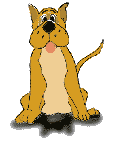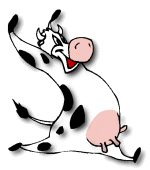




For a lot of us (including me) it is not that straight forward.

At 40, I was still doing mental gymnastics trying to determine left from right. I would eventually figure out which way was left, but not before going through the motions of handwriting (with my right hand) or sticking out both thumbs frantically looking for that tell-tale "L" that stood for left.
By that time I had missed my turnoff if I was driving, or completely forgotten why I was trying to determine "left" in the first place!

So, what's a person to do?
It always puzzled me that if two objects were place in front of me and mentally labeled "A" and "B", I had no trouble distinguishing "A" from "B".
But, if those same two objects were in front of me and I was asked to point out the one on the right, I would (once again) have to go through my mental gymnastics trying to figure it out.
It also occurred to me that it was easier to figure out the great "left-right" mystery if I was driving. Why?

Surprisingly,the answer to this puzzling mystery came to me while I was reading about Dyslexia.
While I am not dyslexic, I am ADD and people with ADD, or Attention Deficit Disorder (a very inappropriate name for it, but...) or dyslexia do have at least one thing in common.
We are both visual thinkers.

Simply put, visual thinkers think in pictures. Non-visual thinkers think in words.
Most people can do both, but tend to be predominantly one or the other. There seems to be a wide spectrum with "word thinking" being at one end, and "visual thinking" being at the other.

Objects are very easy to "see" in one's mind, or to visualize. Think of the word "dog". While your dog may not look like my dog, we will both "see" a dog. It easily creates a visual or mental image.

During my exploration into the world of dyslexia, I discovered that it was seemingly simple words that "disoriented" a person with dyslexia. Words like "and", "the" or "such" could cause that "mental picture screen" to suddenly go blank. (There are about 200 words in the english language that do not readily produce a visual image)


1.) I was a visual thinker.
2.) I could not produce a visual image for the words "left" or "right".
3.) It was easier to figure out left and right while driving because turning left, to me, was crossing traffic (the visual) while turning right was not crossing traffic. (again, the visual cue)
Obviously I needed some kind of visual cue to be able to tell left from right without having to turn my brain inside-out in the process.

 I can remember being frustrated with the great left-right mystery and thinking "Why couldn't they have named it A and B instead of left and right! I can keep A and B straight in my head....but I can't keep left and right straight!"
I can remember being frustrated with the great left-right mystery and thinking "Why couldn't they have named it A and B instead of left and right! I can keep A and B straight in my head....but I can't keep left and right straight!"That is when the light went on!
I held my hands up in front of me, and decided to "name" them A and B. Alphabetical order was easy for me to visualize, so my left hand became A-left, and my right hand became B-right.
A few repitions in my head of A-left, B-right and I finally had it! After 40 years, suddenly I could tell left from right! And without mental gymnastics!

I suppose one could "name" left and right with any kind of word that creates a visual image, but for me the added sequential factor (A always being before B in the alphabet) seems to make determining left or right a lot faster.

Having equiped myself with this new-found knowledge, I decided to undertake....MY STOVE! Yes, my stovetop was a constant nightmare everytime I tried to use it, simply because I couldn't figure out which knob corresponded to which element. It was just as bad as trying to figure out the left-right mystery.

Looking at this confusing household object, I was presented with the 4 elements seen here, and the set of "matching" (???) knobs, which upon closer inspection revealed themselves to be quite mind-boggling!
which upon closer inspection revealed themselves to be quite mind-boggling!

My brain hurt just trying to make sense out of this mass confusion, and even though I was usually able to figure out which knob turned on which element, I still managed to pick the wrong one at least 30% of the time!
If I could name my hands, then why not my stoveknobs too?
First, I put the elements in alphabetical order (in my mind that is, not on the actual stove!)
Like so...

Then I got 4 stickers, labeled them A, B, C, and D and once I made sure I knew which one went where, put them on the knobs. Life has become a lot easier around the stove now!


